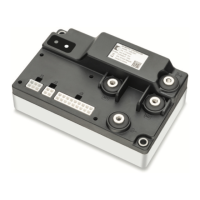2 — INSTALLATION AND WIRING
pg. 19
Return to TOC Curtis Model 1226 – September 2019
Emergency Reverse Input
Emergency reverse is typically used in Class III material handling vehicles. When emergency reverse
is activated, the controller produces a rapid braking force to quickly stop the vehicle, then drives the
vehicle in the opposite direction.
Emergency reverse can be activated by a Normally Open (NO) switch, a Normally Closed (NC)
switch, or both NO and NC switches used as complementary switches. Use the EMR Input Type
parameter to specify which switch(es) is being used; see page 43.
When complementary switches are used for emergency reverse, the controller continually checks
both switches. Table 18 lists which combinations of switches result in valid actions and which result
in faults.
Table 18 Complementary Emergency Reverse States
NO State NC State Valid or Fault? Comments
Off Off Fault
This occurs if the NC connection is broken or the NO
switch is defective. An EMR Switch Redundancy fault
occurs.
Off On Valid Emergency reverse is off.
On Off Valid Emergency reverse is on.
On On Fault
This occurs if the NO switch is shorted or the NC switch is
defective. An EMR Switch Redundancy fault occurs.
You can use the EMR SRO Enable parameter to specify that the vehicle cannot be driven if emergency
reverse is active when the operator turns on the keyswitch. For information on conguring the
emergency reverse feature, see page 42.

